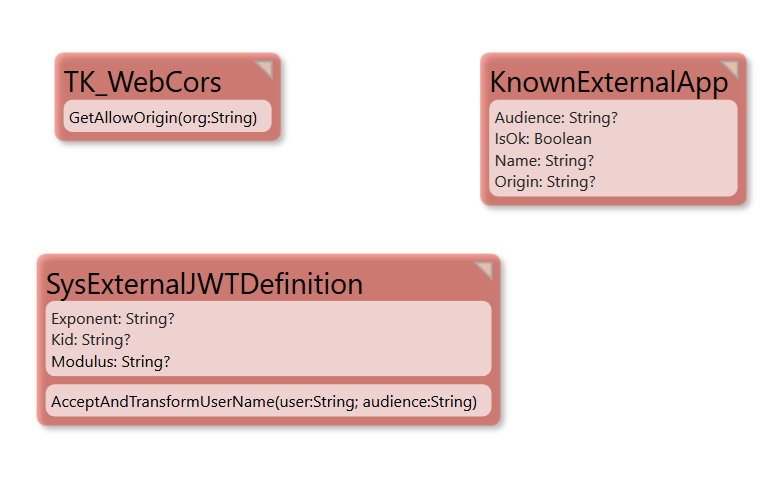No edit summary |
No edit summary |
||
| Line 50: | Line 50: | ||
} | } | ||
} | }</pre>To handle cors and Authentication in the model I follow the stipulated pattern and add this: | ||
[[File:2021-02-28 23h24 21.png|none|thumb|780x780px]] | |||
The methods are implemented like this: | |||
GetAllowOriging: | |||
if KnownExternalApp.allinstances->exists(x|(x.Origin=org) and (x.IsOk)) then | |||
<nowiki> </nowiki> true -- we want to allow this app to call us | |||
else | |||
<nowiki> </nowiki> false | |||
endif | |||
AcceptAndTransformUserName: | |||
if KnownExternalApp.allinstances->exists(x|(x.Audience=audience) and (x.IsOk)) then | |||
<nowiki> </nowiki> user -- we want to allow all users from this domain if they exists in our domain | |||
else | |||
<nowiki> </nowiki> <nowiki>''</nowiki> | |||
endif | |||
<pre> | |||
</pre> | </pre> | ||
Revision as of 22:28, 28 February 2021
In order to connect SPA's built with pure-javascript or React or Angular or Vue or anthing else we must address these needs:
- Cors - allow foreign apps to query our Turnkey server
- Authentication - allow foreign apps to acquire a jwt from somewhere (Oauth host) and we want to check it and possibly accept it
- Stay logged in - with a cookie after initial authentication
To show this we can use the Microsoft SPA example from here : https://docs.microsoft.com/en-us/azure/active-directory/develop/tutorial-v2-javascript-auth-code
If you follow all the instructions there you soon have a SPA application that logs in with Azure AD - and gives you idToken that are in jwt format (really jws as they are signed).
Once you have this example - follow the lead and add another button, just like the readMail and seeProfile buttons from the sample:
function readTurnkey() {
getTokenPopup(loginRequest)
.then(response => {
const headers = new Headers();
const bearer = `Bearer ${response.idToken}`;
const endpoint ='http://localhost:5052/TurnkeyRest/Get?command=RestExample'
headers.append("Authorization", bearer);
const options = {
method: "GET",
headers: headers
};
console.log('request made to Turnkey API at: ' + new Date().toString());
fetch(endpoint, options)
.then(response => response.json())
.then(response => updateUI(response, endpoint))
.catch(error => { console.log(error); });
}).catch(error => {
console.error(error);
});
}
What we do here is to acquire a new idToken, and sending it to a Turnkey Rest api that in this case is at http://localhost:5052/TurnkeyRest/Get?command=RestExample
The json we get from this call is sent to updateUI where we do this:
else {
// turnkey data:
try {
profileDiv.innerHTML = JSON.stringify(data);
}
catch (err) {
profileDiv.innerHTML = data.toString();
}
}To handle cors and Authentication in the model I follow the stipulated pattern and add this:
The methods are implemented like this:
GetAllowOriging: if KnownExternalApp.allinstances->exists(x|(x.Origin=org) and (x.IsOk)) then true -- we want to allow this app to call us else false endif AcceptAndTransformUserName: if KnownExternalApp.allinstances->exists(x|(x.Audience=audience) and (x.IsOk)) then user -- we want to allow all users from this domain if they exists in our domain else '' endif

